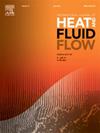Direct numerical simulation of turbulent flow and heat transfer in a particle-laden turbulent channel flow
IF 2.6
3区 工程技术
Q2 ENGINEERING, MECHANICAL
International Journal of Heat and Fluid Flow
Pub Date : 2024-11-02
DOI:10.1016/j.ijheatfluidflow.2024.109617
引用次数: 0
Abstract
Direct numerical simulation (DNS) is conducted to investigate the impact of solid particles on heat transfer in a plane channel flow. For comparison, two corresponding DNSs of unladen channel flow are also performed. The numerical simulation of the particle-laden case employs a two-way coupled Eulerian–Lagrangian computational model, which allows for the consideration of momentum transfer between the two phases: discrete particles and the continuous fluid phase. The presence of particles results in an increase in the mean temperature, the root mean square (rms) of temperature fluctuations, and the streamwise turbulent heat flux within the core region. Furthermore, particles exert a more significant influence on these characteristics at higher solid volume fractions. Additionally, the correlation between velocity and temperature is affected by the presence of particles. When comparing heat transfer in particle-laden channel flow to that in the corresponding unladen channel flow, it is observed that the difference in heat flux arises from changes in the rms of the wall-normal velocity and temperature fluctuations. The impact of particles on turbulent heat flux transport is significant in the vicinity of the wall, while their influence within the core region is relatively small.
富含颗粒的湍流通道流中湍流和传热的直接数值模拟
我们进行了直接数值模拟(DNS),以研究固体颗粒对平面通道流传热的影响。为了进行比较,还对无负载通道流进行了两次相应的 DNS 模拟。载颗粒情况的数值模拟采用了双向耦合欧拉-拉格朗日计算模型,可以考虑两相(离散颗粒和连续流体相)之间的动量传递。颗粒的存在导致核心区域内的平均温度、温度波动均方根(rms)和流向湍流热通量增加。此外,固体体积分数越高,颗粒对这些特性的影响越明显。此外,颗粒的存在也会影响速度和温度之间的相关性。在比较含有颗粒的通道流与相应的未含有颗粒的通道流的传热时,可以发现热通量的差异来自于壁面正常速度和温度波动的均方根值的变化。颗粒对湍流热通量传输的影响在壁面附近非常明显,而在核心区域内则相对较小。
本文章由计算机程序翻译,如有差异,请以英文原文为准。
求助全文
约1分钟内获得全文
求助全文
来源期刊

International Journal of Heat and Fluid Flow
工程技术-工程:机械
CiteScore
5.00
自引率
7.70%
发文量
131
审稿时长
33 days
期刊介绍:
The International Journal of Heat and Fluid Flow welcomes high-quality original contributions on experimental, computational, and physical aspects of convective heat transfer and fluid dynamics relevant to engineering or the environment, including multiphase and microscale flows.
Papers reporting the application of these disciplines to design and development, with emphasis on new technological fields, are also welcomed. Some of these new fields include microscale electronic and mechanical systems; medical and biological systems; and thermal and flow control in both the internal and external environment.
 求助内容:
求助内容: 应助结果提醒方式:
应助结果提醒方式:


